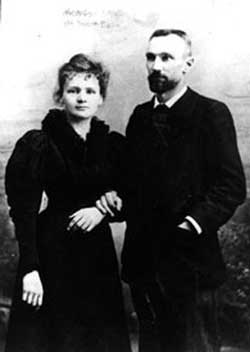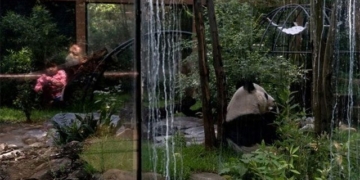As we enter the Nobel Prize award season in 2005, we proudly present the most remarkable family in the history of this prestigious award through the article by author Trần Thanh Minh.
No family has held as many records related to the Nobel Prize as the Curie family. Their achievements are impressive: five individual laureates, two married couples, and one woman with a “double” (two Nobel Prizes).
 |
| The spouses of the scientist Marie Curie and Pierre Curie |
The events described here, in accordance with the principles of the Nobel Prize, clearly reflect the brilliance of some of the most exceptional ideas, and the immense contributions of a family to the development of human civilization and the happiness of humanity. Pierre Curie and Marie Curie, Irène Curie and Frédéric Joliot-Curie—these names shone brightly in the early decades of the 20th century, a period regarded as the dawn of today’s atomic nuclear age. They laid the foundational stones for the birth of new scientific fields that are not only profoundly scientific but also widely applicable in various aspects of life.
THE CONTINUITY OF TALENT AND CHARACTER
If the greatest glory of a Mother is to give birth and nurture her children, continuing and elevating the family legacy to new heights, then Marie Curie was such a Mother. Her daughter Irène Joliot-Curie and son-in-law Frédéric Joliot-Curie excellently carried on the talent, character, and legacy of the previous generation through groundbreaking inventions and significant social contributions.
New Nobel Prize, New Contributions, New Generation
The first scientific invention and the most profound legacy of Frédéric and Irène Joliot-Curie was the creation of radioactive isotopes not found in nature. The Joliots conducted a series of experiments with unique and innovative ideas: using a beam of helium ions from an accelerator to strike targets made of materials such as Boron, Aluminum, and Magnesium. This new generation of scientists successfully created previously unknown radioactive isotopes, including Nitrogen (N-13), Phosphorus (P-30), and Aluminum (Al-28).
With their invention, humanity was able for the first time to manufacture artificial atoms or isotopes. This breakthrough paved the way for the production of many different artificial radioactive isotopes, even allowing for the creation of gold and silver, fulfilling the ancient dreams of alchemists. Many suitable artificial radioactive isotopes can serve as “detectives” to monitor and control technological processes, explore metabolic exchanges in the living bodies of plants and animals, and more.
Thus, talent followed talent; after their parents discovered natural radioactive elements, the Curie children succeeded in creating artificial radioactive isotopes. The two generations of the Curie family indeed “roamed” for three decades, uncovering most new phenomena, new concepts, and fundamental discoveries, unveiling many mysteries in the material world, and discovering fascinating natural phenomena and laws with previously unknown concepts, such as radiation beams, radioactivity, natural and artificial radioactivity, nuclear reactions, and more. They harmoniously addressed the most captivating questions to usher in the atomic energy era.
Notably, the inventions of the Curie family—from Pierre and Marie to Frédéric and Irène—related to radiation and radioactive materials, paved the way for new scientific applications. Beyond radiological medicine, such as radiation technology, radiobiology, and radiation safety, these nuclear engineering applications significantly impacted economic development and affected the fates of many individuals. They are so practical and widespread that we can now see them in many places around us. A clinic treating serious diseases with radium needles and cobalt radioactive sources. An oil drilling rig using radioactive core sampling equipment. A quality control station for construction using non-destructive testing devices that utilize gamma radiation. A laboratory for hybridizing new species using radioactive sources to induce mutations. An automated control system for production lines using beta or gamma rays. A radiobiology research facility serving the needs of increasing livestock and crop productivity, and much more.
Following in the footsteps of their predecessors, the renowned scientists Frédéric Joliot and Irène Joliot-Curie truly embody the phrase “like father, like son.” They contributed to humanity with a monumental invention, “The Creation of New Radioactive Elements (Artificial Radioactive Materials),” deserving the highest honor in the scientific community, the Nobel Prize in Chemistry in 1935.
Thus, in the history of the Nobel Prize, there have been four couples who have received the award, with the Curie family occupying two of those slots. Frédéric Joliot-Curie also holds the record as the youngest Nobel laureate in the history of the Nobel Prize in Chemistry at the age of 35.
Two Scientists, Two Warriors, One Shared Life
Frédéric and Irène Joliot-Curie, despite their different personalities and backgrounds—one being reserved and the other lively and active, one born into an esteemed intellectual cradle and the other self-made—these two equally talented individuals remained closely bonded throughout their lives, complementing each other and forming a brilliant partnership. They were colleagues who shared in every scientific success, comrades in all social and political activities, embodying noble character and boundless enthusiasm.
Both committed to higher education, Professor Frédéric Joliot-Curie at the University of Paris led the construction of the latest accelerators in Europe, while Professor Irène Joliot-Curie at the University of Orsay guided the establishment of a Physics Laboratory, which remains a renowned cradle for nurturing talent.
Sharing a passion for scientific research, the patent for artificial radioactive isotopes and the 1935 Nobel Prize in Chemistry were the remarkable outcomes of the collaboration between these two great scientists.
Not stopping there, Irène continued to stand beside Frédéric, independently working with many renowned scientific groups of the time, such as Fermi in Rome and Hahn in Berlin, to replicate her nuclear reaction experiments. All of them were surprised to achieve nuclear fission reactions, specifically the splitting of uranium nuclei into two fragments using a beam of neutron “bullets,” releasing a significant amount of energy. This event opened the door to a revolution in energy during the 20th century with the emergence of the atomic power industry, leading to a dramatic shift in the global military landscape with the introduction of a terrifying new type of weapon.
Based on that result, Frédéric Joliot-Curie, in October 1939, designed the principles of a nuclear reactor. However, World War II broke out. Across the Atlantic, in the courtyard of Columbia University (USA), Fermi and his colleagues peacefully built a reactor. On the other hand, Joliot’s designs and aspirations were sealed in an envelope, lying dormant in the top-secret archives of the French Academy of Sciences. The author of that design left the laboratory to join the national resistance, ready to take on any job. Sometimes he acted as a “warehouse keeper,” carrying important secret documents and valuable heavy water to prevent them from falling into the hands of the German army. At other times, he worked as a military engineer, involved in manufacturing explosives. He was even tasked with serving as a commander of a corps or president of the resistance organization “National Front.”
Nearly ten years later, when the war ended, Frédéric Joliot-Curie’s dream finally became a reality. The first nuclear reactor in France was constructed in 1948, following his design and direct supervision.
France had a high level of trust in both outstanding scientists. Irène was appointed Minister responsible for science in the Popular Front government (1936) and was the first to establish the National Center for Scientific Research (CNRS) in France. Frédéric was tasked in 1945 with organizing the Atomic Energy Commission (CEA) and directly running it in the role of its first High Commissioner, while Irène served as a member of the CEA leadership. In return, Frédéric also held the position of Director of the largest research center in France, CNRS, which his wife had created during her time as Minister of Science.
Then tragedy struck the Joliot-Curies. This personal tragedy mirrored the broader tragedy of world history in the 20th century. Both unexpectedly left the important CEA agency (1950) with a dismissal that did not state the reasons. Of course, everyone understood that during the Cold War, they could not continue their missions as they were communists who had participated in the anti-fascist resistance led by the French Communist Party. Notably, during that period, the CEA had a crucial mission to develop nuclear weapons, while these two scientists held anti-war views and participated in the peace movement.
Immediately after this, they actively participated in leading the World Peace Movement, with Frédéric serving as President and Irène as a member of the leadership council.
In science, the two combined their exceptional talents to create a significant legacy. At a new turning point in their lives, these two individuals with noble characters stood together for a great ideal, fighting for peace and the progress of humanity. They dedicated themselves as warriors on the front lines during the national resistance, until the end of their lives.
Today, France—a nuclear power with 80% of its electricity generated from nuclear energy—certainly rightfully honors the two nuclear scientists, Frédéric Joliot-Curie and Irène Joliot-Curie, the principal authors of the first nuclear reactor in France, the founding figures of France’s atomic energy sector. They are a source of pride for France.
Conclusion
It would be incomplete to forget that the Curie family has another member who was also awarded the Nobel Prize. That is the son-in-law, an American diplomat named H.R. Labouisse, the husband of Pierre’s daughter, Eve Curie. He made outstanding contributions to humanity in his role as Director of the UNICEF. He was awarded the Nobel Peace Prize in Oslo (Norway) in 1965. Eve Curie did not follow the scientific path of her parents and siblings, but she admired them and kept up with their work. As a renowned writer, she praised their careers, especially her great Mother, through the famous book “Marie Curie.” With the achievements of her son-in-law Labouisse, the Curie family set another record: Five members of one family have been honored with the Nobel Prize.
Five individuals, Two couples, One woman receiving a “double” Nobel Prize, etc. No family has matched the Curie family’s records regarding prestigious Nobel Prizes. The convergence of such intellectual peaks within the Curie family is indeed remarkable. Remarkable as if it were a legend of the 20th century.
Trần Thanh Minh
















































